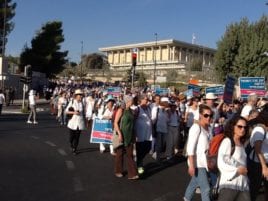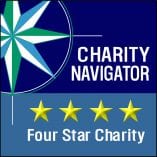
Fast forward fifty-three years later, and the grassroots Israeli-Palestinian “Women Wage Peace” movement decided on the same format; rallies throughout the country followed by a rally in Jerusalem. So during the week of the Sukkot holiday, I found myself standing at the official Israeli-Jordanian border crossing between Eilat and Aqaba with members of the southern Arava valley communities including Kibbutz Ketura and students, staff, and faculty of the Arava Institute. The message of the rally was women demanding, with men invited to participate, a model of political leadership that would transform decades of failure when it comes to a settlement of the Palestinian-Israeli conflict. “Right, Center, Left Demand a Peace Agreement” was the slogan of the rally. After a march along the Eilat promenade there were a number of speeches including one by the mayor of Eilat.
The following day many of us got up before the sun so we could travel first to Qasr al-Yahud, the Jordan River Baptist site and then onto Jerusalem. At Qasr al-Yahud we joined together with hundreds of Palestinians. People shared smiles, food, and a sense of doing something important together. It was a powerful sight as we marched, many hand in hand, from the gathering point to the baptismal site.
There, participants mingled with Christian pilgrims who had come to the site for baptism ceremonies. The Jordan River at that point is some fifteen feet wide and on both sides steps allow pilgrims easy access to its holy waters. A member of Kibbutz Ketura pointed out a man with white beard sitting on the Jordanian side of the river who had visited the Arava Institute shortly after our arrival this summer! He owns a farm near that spot and is working with Dr. Clive Lipchin, the Director of our Center for Transboundary Water Management, and Arava alumnus and researcher Suleiman Halasah, to install the prototype of a new solar desalination system in Jordan. He came to support the March from the Jordanian side of the border. I called across the river and border. He immediately recognized me and we had a conversation much to the delight and surprise of those who listened to us. This extraordinary encounter modelled what the Arava Institute is capable of creating, and by extension what the Women Wage Peace event was all about.
The rally was addressed by Liberian Nobel Peace Prize laureate Leymah Roberta Gbowee, whose story of empowerment, bravery, and strength resonated with the marchers. From Qasr al-Yahud we continued on our way to Jerusalem, where our numbers swelled to 20,000 as we marched past Israeli government ministry buildings, the Knesset, the Prime Minister’s office, the President’s House, and finally ended up a block from the Prime Minister’s residence. The marchers’ spirits were uplifted by the sight of so many people snaking their way through the streets and neighborhoods of Jerusalem. At the final rally, Yael Deckelbaum led us in her touching song “Prayer of the Mothers”.
The day was called the March of Hope. Hope is one of the great motivating forces in our lives; it allows us to reach forward to what we want. The day was a strong reminder of what can be. The activities of the Arava Institute are daily reminders that hope can also be lived as a reality.
Rabbi Michael Cohen teaches conflict resolution at Bennington College’s Center for the Advancement of Public Action (CAPA). He is one of the founding faculty members of the Arava Institute and continues to support its work from near and far. During the Fall 2016 semester, which he is spending in Kibbutz Ketura with his wife Alison, he is teaching the course “The Bible as a Key to Environmental Thought”, and blogging regular reflections on the Arava Institute and its surroundings.

